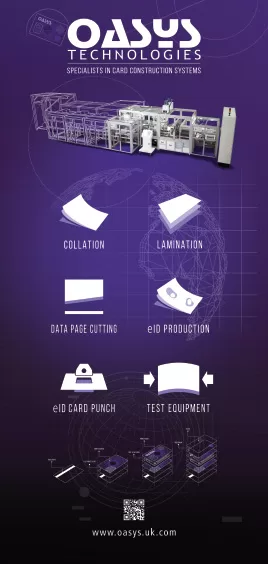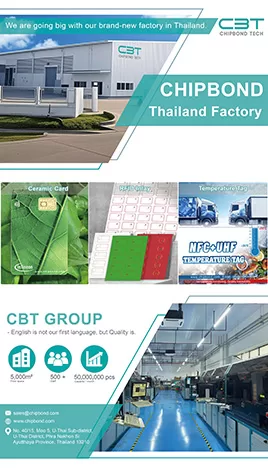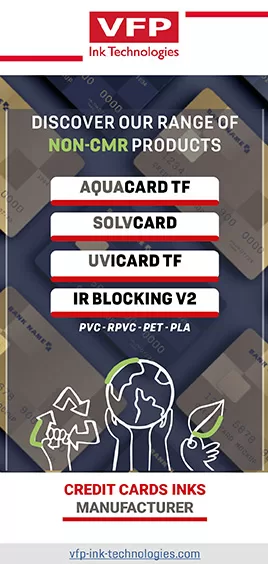
by Jennifer Kohlhepp | CM Magazine Featured
Eco-Friendly Materials in Card Manufacturing
 By David Tushie – Magellan Consulting, Inc., ICMA Standards and Technical Representative
By David Tushie – Magellan Consulting, Inc., ICMA Standards and Technical Representative
Worldwide, we have seen increased concern with climate change and action to mitigate its progress. In the card industry this has translated into increasing issuer demand for reduced content and a high percentage of recycled PVC as well as alternative bio-based materials.
This increased issuer interest is reflected in the June 2018 announcement by American Express that it would issue cards in 2019 produced using recovered ocean waste plastic. The company announced a partnership with an organization called “Parley,” which is dedicated to combating marine plastic pollution. Further, the company identified a prototype card in development using “upcycled” marine plastic debris and are in the longer-term refinement of this process.
In the fall of 2019, CPI Card Group announced its new “Second Wave” payment card product. Based on what the company calls “recovered ocean-bound plastic;” plastic recovered within 50 km from a seashore or rivers and streams that lead to the ocean. The company cited various sources that project plastic in the oceans will exceed the weight of all the fish in the next 30 years, if today’s consumption and disposal trends continue!
Mastercard announced in November 2018 that it had formed an industry collaboration to develop environmentally friendly cards. Known as the Greener Payments Partnership, G&D Mobility, IDEMIA and GemaltoThales are all participants. Reduction in first-use PVC plastic in card manufacturing, adoption of environmentally friendly materials on a larger scale and recyclable, bio-sourced and bio-degradable materials for card manufacturing are all in the vision of this group.
CaixaBank in Spain announced in September 2019 that it is starting to issue prepaid debit cards made primarily of PLA. The company’s anticipated annual production is 150,000 cards. It also indicated that the card production process reduces the carbon footprint by nearly half that of conventional PVC (15.5 kg CO2 per 1,000 cards vs 30 kg CO2 per 1,000 cards).
Finally, Evolis announced earlier this year its new initiative to provide paper cards in ID-1 size for monochrome printing, utilizing their printers, for limited used card applications like visitor ID badges, event badges, hotel luggage cards, etc. All of these are recent examples of the movement to reduce the carbon footprint of plastic cards.
The three primary material choices available to card issuers and manufacturers when the goal is to reduce carbon footprint, are recycled PVC, reduced content PVC and alternative materials. Recycled content is a subject of recent announcements over the past year from plastic film suppliers. High percentage recycled content is now available from major suppliers. But reduced material use is also an alternative in many applications. Transit tickets, many forms of ID cards and metal composite cards are just a few examples where reduced plastic content is possible. When we talk about alternative materials, biodegradation in landfills or the environment is the desired outcome. However, it is important to recognize that all decomposition is not equal!
There is a common misunderstanding that products labeled “biodegradable” will decompose in the landfill and are therefore better for the environment. However, due to the oxygen-poor and dry conditions associated with most landfills, aerobic decomposition does not take place, and anaerobic decomposition takes place very slowly. The European Union considers a material to be biodegradable if it will break down into mostly carbon dioxide, water and organic matter within six months of being put into a composting facility. Biodegradation is aerobic activity by biological organisms. However, not all biodegradation produces “humus.” Compost is defined by biodegradation that produces a stable humus (a biomass that supports plant growth). By recognizing the most likely method of disposal, it is possible to measure, evaluate and compare the impact of the most likely decomposition mechanisms. This is a critical first step in managing the impact of materials and products in an environmentally friendly manner.
Accurately calculating recycled or reduced content plastic is critical in making product claims. Similarly, testing for biodegradation with alternative materials is necessary for products using these materials. ICMA’s EcoLabel Program provides guidance to card manufacturers for all three of these possibilities.
For both recycled and reduced material content, methods are defined to calculate and report these. However, there are no test methods. There is an equation for calculating the percentage of recycled content in a card product when the primary method uses the mass of recycled material content and the total mass of the unpersonalized card. An alternative calculation is offered where the percentage of raw recycled material and mass of the recycled material are known. This is likely the calculation you would make if you purchased a specified recycled content plastic film from a supplier. In both calculations, the result is a percentage of recycled content in a finished, unpersonalized card but neither contains a test method or criteria. There is also a defined calculation for reduced material content, expressed as a percentage. It compares the mass of an unpersonalized card manufactured from reduced content plastic to that of a standard, unpersonalized ID-1 card of the same base material. Again, no test method or criteria are specified. There really is nothing to test.
Compostability (biodegradation) is where test methods are defined and minimum achievable criteria are stated. ISO 17088 is the basic ISO standard specification for compostable plastic materials. It is not, per se, a test method. ISO 14855 is referenced as the test method to be used. Its most basic requirement is that 90% of organic carbon, relative to the control sample, must be converted to CO2 by the end of the test period, not to exceed 180 days. In general, these test methods can involve time periods from six months to one year to finish. And prior to testing, preparation and analysis of the compost inoculum is required, which can take another three months. These are much longer tests than we are normally used to in card testing, so some planning is required!
With the accelerating interest in greenhouse gas reduction around the globe, card manufacturing will see an increasing scrutiny of its materials of construction. Recycled content, reduced content and alternative materials are all in the solution set. The ICMA EcoLabel standard and program materials provide both guidance and leadership in the card industry to address this need. The standard is posted in the ICMA online Member Portal.
About the Author: ICMA Standards and Technical Representative David Tushie has had a long and continuing career in the card industry working for international companies such as Datacard, UbiQ and NBS Technologies. He has master’s degrees in engineering and business, holds U.S. and international patents in measurement and card issuance systems and has had several years of involvement with the ANSI, INCITS and ISO standards process. ICMA is represented at six ISO and ANSI standards meetings through his standards role within the association.






